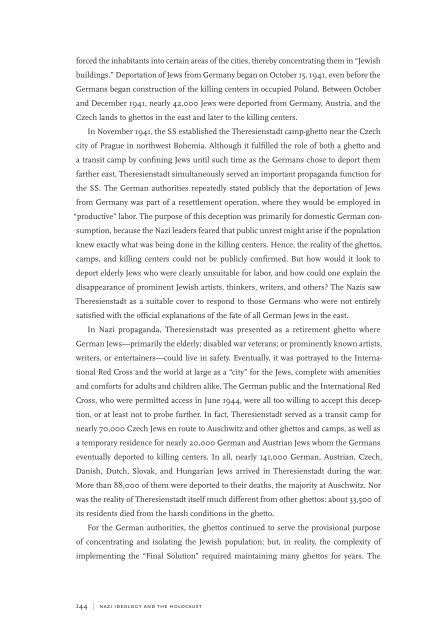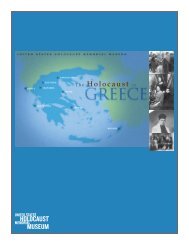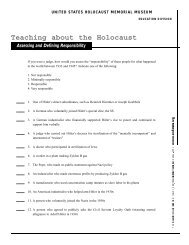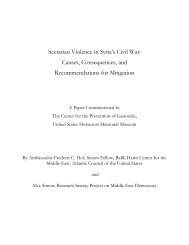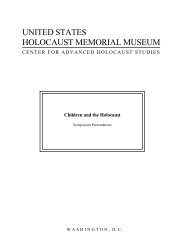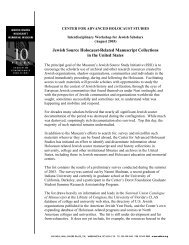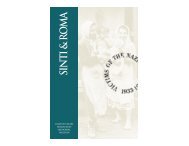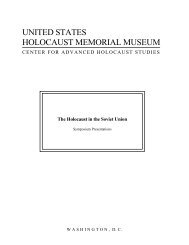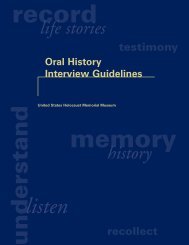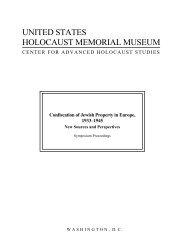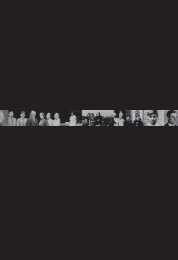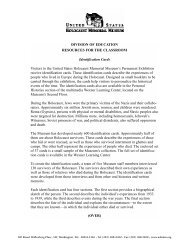the quest for racial purity - United States Holocaust Memorial Museum
the quest for racial purity - United States Holocaust Memorial Museum
the quest for racial purity - United States Holocaust Memorial Museum
Create successful ePaper yourself
Turn your PDF publications into a flip-book with our unique Google optimized e-Paper software.
<strong>for</strong>ced <strong>the</strong> inhabitants into certain areas of <strong>the</strong> cities, <strong>the</strong>reby concentrating <strong>the</strong>m in “Jewish<br />
buildings.” Deportation of Jews from Germany began on October 15, 1941, even be<strong>for</strong>e <strong>the</strong><br />
Germans began construction of <strong>the</strong> killing centers in occupied Poland. Between October<br />
and December 1941, nearly 42,000 Jews were deported from Germany, Austria, and <strong>the</strong><br />
Czech lands to ghettos in <strong>the</strong> east and later to <strong>the</strong> killing centers.<br />
In November 1941, <strong>the</strong> SS established <strong>the</strong> Theresienstadt camp-ghetto near <strong>the</strong> Czech<br />
city of Prague in northwest Bohemia. Although it fulfilled <strong>the</strong> role of both a ghetto and<br />
a transit camp by confining Jews until such time as <strong>the</strong> Germans chose to deport <strong>the</strong>m<br />
far<strong>the</strong>r east, Theresienstadt simultaneously served an important propaganda function <strong>for</strong><br />
<strong>the</strong> SS. The German authorities repeatedly stated publicly that <strong>the</strong> deportation of Jews<br />
from Germany was part of a resettlement operation, where <strong>the</strong>y would be employed in<br />
“productive” labor. The purpose of this deception was primarily <strong>for</strong> domestic German con-<br />
sumption, because <strong>the</strong> Nazi leaders feared that public unrest might arise if <strong>the</strong> population<br />
knew exactly what was being done in <strong>the</strong> killing centers. Hence, <strong>the</strong> reality of <strong>the</strong> ghettos,<br />
camps, and killing centers could not be publicly confirmed. But how would it look to<br />
deport elderly Jews who were clearly unsuitable <strong>for</strong> labor, and how could one explain <strong>the</strong><br />
disappearance of prominent Jewish artists, thinkers, writers, and o<strong>the</strong>rs? The Nazis saw<br />
Theresienstadt as a suitable cover to respond to those Germans who were not entirely<br />
satisfied with <strong>the</strong> official explanations of <strong>the</strong> fate of all German Jews in <strong>the</strong> east.<br />
In Nazi propaganda, Theresienstadt was presented as a retirement ghetto where<br />
German Jews—primarily <strong>the</strong> elderly; disabled war veterans; or prominently known artists,<br />
writers, or entertainers—could live in safety. Eventually, it was portrayed to <strong>the</strong> International<br />
Red Cross and <strong>the</strong> world at large as a “city” <strong>for</strong> <strong>the</strong> Jews, complete with amenities<br />
and com<strong>for</strong>ts <strong>for</strong> adults and children alike. The German public and <strong>the</strong> International Red<br />
Cross, who were permitted access in June 1944, were all too willing to accept this deception,<br />
or at least not to probe fur<strong>the</strong>r. In fact, Theresienstadt served as a transit camp <strong>for</strong><br />
nearly 70,000 Czech Jews en route to Auschwitz and o<strong>the</strong>r ghettos and camps, as well as<br />
a temporary residence <strong>for</strong> nearly 20,000 German and Austrian Jews whom <strong>the</strong> Germans<br />
eventually deported to killing centers. In all, nearly 141,000 German, Austrian, Czech,<br />
Danish, Dutch, Slovak, and Hungarian Jews arrived in Theresienstadt during <strong>the</strong> war.<br />
More than 88,000 of <strong>the</strong>m were deported to <strong>the</strong>ir deaths, <strong>the</strong> majority at Auschwitz. Nor<br />
was <strong>the</strong> reality of Theresienstadt itself much different from o<strong>the</strong>r ghettos: about 33,500 of<br />
its residents died from <strong>the</strong> harsh conditions in <strong>the</strong> ghetto.<br />
For <strong>the</strong> German authorities, <strong>the</strong> ghettos continued to serve <strong>the</strong> provisional purpose<br />
of concentrating and isolating <strong>the</strong> Jewish population; but, in reality, <strong>the</strong> complexity of<br />
implementing <strong>the</strong> “Final Solution” required maintaining many ghettos <strong>for</strong> years. The<br />
144 | nazi ideology and <strong>the</strong> holocaust


